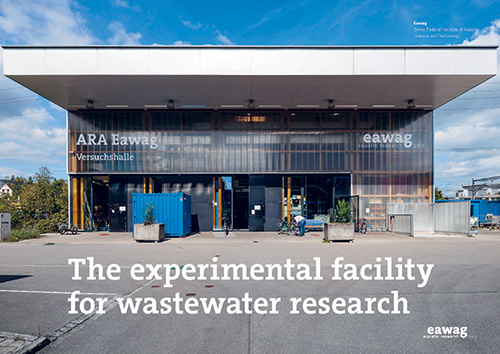The experimental facility for wastewater research
STEP Eawag

Better understanding and optimising wastewater treatment
The experimental facility on the Eawag site is an important element of wastewater research at Eawag. It is home to a wastewater treatment plant – the Eawag WWTP, which is operated with real wastewater from the town of Dübendorf. There are also areas for various experiments with pilot plants, a large number of small reactors as well as laboratories and workshops. The installations are used by Eawag’s process engineering department to gain an even better understanding of methods and processes relevant to modern wastewater treatment and to further develop and optimise them on a smaller scale. For example, research is being carried out into when and where nitrous oxide – one of the main greenhouse gases – is produced in wastewater treatment plants. In order to develop and test new processes, researchers usually work together with practice partners.
The experimental facility is also used by other Eawag departments for wastewater research and interdisciplinary projects. Students and doctoral candidates are trained here.
Furthermore, in the experimental facility, pilot plants are being developed, built, and tested that enable new processes to be implemented in existing municipal wastewater treatment plants and tested under practical conditions.
The Eawag wastewater treatment plant (WWTP)
The experimental facility’s wastewater treatment plant is connected to the sewage system of the town of Dübendorf. Both the composition and the dynamics of the volume of wastewater produced therefore correspond to real conditions. Unique for a research plant is also its capacity of around 72 m3 per day, which corresponds to the daily wastewater volume of around 200 people.
Swiss wastewater treatment plants work with different processes, which can be replicated at Eawag’s WWTP and flexibly combined as required. For example, the installation can be operated as a continuously fed flow-through system or as a sequencing batch reactor system. The primary treatment can be either with classic sedimentation or with a microsieve. Special processes with biofilm carriers or granulated biomass are also possible.
Investigations into sewage sludge treatment can also be carried out on a smaller scale – from digestion and sludge watering to sludge incineration.
Wastewater (pre-)treated at Eawag’s WWTP and the resulting sewage sludge also serve as the basis for further research projects. At the end of each process, the wastewater is returned to the sewage system.

2. Exhaust air measurement: nitrous oxide emissions can be recorded here, for example
3. Small reactors on a 12-litre scale for tests on the degradation rates of pollutants with various activated sludges and wastewater
4. Laboratories: samples from wastewater can be processed and analysed straight away
5. Workshops: experimental facilities are built and maintained here
6. Area for various experiments with wastewater and sewage sludge as well as pilot plants, such as wastewater filters
7. Storage area for mobile containerised wastewater treatment plants that can be used in municipal wastewater treatment plants to test new processes
(Figure: grafikvonfrauschubert, Eawag)










